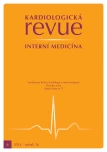Penetrating cardiac injury – review
Authors:
J. Konečný 1; M. Šimek 1; A. Klváček 1; R. Hájek 1; J. Škorpil 2; P. Hubáček 3; V. Lonský 1
Authors‘ workplace:
Kardiochirurgická klinika LF UP a FN Olomouc
1; Kardiochirurgické oddělení, FN Plzeň
2; Oddělení urgentního příjmu, FN Olomouc
3
Published in:
Kardiol Rev Int Med 2014, 16(6): 512-515
Category:
Cardiology Review
Overview
Penetrating cardiac injury remains a highly lethal form of trauma today. Although the incidence in European countries is low (approximately 0.1% of all hospital ‑ admitted traumas), the mortality rate ranges between 80 and 94% due to cardiac tamponade or exsanguination. Due to the anatomic position of the heart, right ventricle injury dominates, followed by injury of the left ventricle, right atrium, and great vessels. Concomitant coronary artery injury is present in 3 – 9% of all cases. The only meaningful treatment is a scoop ‑ and ‑ run approach and emergency operative intervention. Pericardial effusion (> 5mm) confirmed by sonography or CT‑angiography in a thoracic penetrating trauma is an indication for surgical intervention. Hemodynamic instability, cardiac arrest, electromagnetic dissociation and prolonged injury ‑ to ‑ gate time represent independent risk factors for death. However, the survival rate of patients revised by a cardiothoracic surgeon ranges from 80% to 100%, with a high chance of returning back to normal life.
Keywords:
heart injury – penetrating injury – review
Sources
1. Rashid MA, Lund JT. Trauma to the heart and thoracic aorta: the Copenhagen experience. Interact Cardiovasc Thorac Surg 2003; 2 : 53 – 57.
2. Kang N, Hsee L, Rizoli S et al. Penetrating cardiac injury: overcoming the limits set by Nature. Injury 2009; 40 : 919 – 927. doi: 10.1016/ j.injury.2008.12.008.
3. Campbell NC, Thomson SR, Muckart DJ et al. Review of 1198 cases of penetrating cardiac trauma. Br J Surg 1997; 84 : 1737 – 1740.
4. Henderson VJ, Smith SR, Fry WR et al. Cardiac injuries: analysis of an unselected series of 251 cases. J Trauma 1994; 36 : 341 – 348.
5. Asensio JA, Petrone P, Pereira B et al. Penetrating cardiac injuries: a historic perspective and fascinating trip through time. J Am Coll Surg 2009; 208 : 462 – 472. doi: 10.1016/ j.jamcollsurg.2008.12.011.
6. Rehn L. Uber penetrirende herzwunden und herznaht. Arch Klin Chir 1897; 55 : 315 – 329.
7. Rehn L. Zur chirurgie des herzens und des herzbeutels. Arch Klin Chir 1907; 83 : 723 – 778.
8. Asensio JA, Garcia ‑ Nunez LM, Petrone P. Trauma to the heart. In: Feliciano DV, Mattox KL Moore EE (eds). Trauma. 6th ed. New York: McGraw Hill 2008 : 569 – 588.
9. Karmy ‑ Jones R, van Wijngaarden MH, Talwar MK et al. Penetrating cardiac injuries. Injury 1997; 28 : 57 – 61.
10. Asensio JA, Soto SN, Forno W et al. Penetrating cardiac injuries: a complex challenge. Injury 2001; 32 : 533 – 543.
11. Reissman P, Rivkind A, Jurim O et al. Case report: the management of penetrating cardiac trauma with major coronary artery injury ‑ is cardiopulmonary bypass essential. J Trauma 1992; 33 : 773 – 775.
12. Karrel R, Shaffer MA, Franaszek JB. Emergency diagnosis, resuscitation, and treatment of acute penetrating cardiac trauma. Ann Emerg Med 1982; 11 : 504 – 517.
13. Claude S, Beck CS. Two cardiac compression triads. JAMA 1935; 104 : 714 – 716.
14. Nagy KK, Lohmann C, Kim DO et al. Role of echocardiography in the diagnosis of occult penetrating cardiac injury. J Trauma 1995; 38 : 859 – 862.
15. Rozycki GS, Feliciano DV, Ochsner MG et al. The role of ultrasound in patients with possible penetrating cardiac wounds: a prospective multicenter study. J Trauma 1999; 46 : 543 – 551.
16. Patel AN, Brennig C, Cotner J et al. Successful diagnosis of penetrating cardiac injury using surgeon ‑ performed sonography. Ann Thorac Surg 2003; 76 : 2043 – 2046.
17. Gavant ML. Helical CT grading of traumatic aortic injuries. Impact on clinical guidelines for medical and surgical management. Radiol Clin North Am 1999; 37 : 553 – 574.
18. Navid F, Gleason TG. Great vessel and cardiac trauma: diagnostic and management strategies. Semin Thorac Cardiovasc Surg 2008; 20 : 31 – 38. doi: 10.1053/ j.semtcvs.2007.11.007.
19. Søreide K, Petrone P, Asensio JA. Emergency thoracotomy in trauma: rationale, risks, and realities. Scand J Surg 2007; 96 : 4 – 10.
20. Feliciano DV, Burch JM, Mattox KL et al. Balloon catheter tamponade in cardiovascular wounds. Am J Surg 1990; 160 : 583 – 587.
21. Macho JR, Markison RE, Schecter WP. Cardiac stapling in the management of penetrating injuries of the heart: rapid control of hemorrhage and decreased risk of personal contamination. J Trauma 1993; 34 : 711 – 715.
22. Škorpil J, Kohut M, Hájek T. Novinky v léčbě poranění srdce. Praha: Maxdorf 2014.
23. Mattox KL, Limacher MC, Feliciano DV et al. Cardiac evaluation following heart injury. J Trauma 1985; 25 : 758 – 765.
24. Tyburski JG, Astra L, Wilson RF et al. Factors affecting prognosis with penetrating wounds of the heart. J Trauma 2000; 48 : 587 – 790.
Labels
Paediatric cardiology Internal medicine Cardiac surgery CardiologyArticle was published in
Cardiology Review

2014 Issue 6
Most read in this issue
- Aortic diseases – diagnosis, classification and management principles
- Combination of anticoagulant and antiaggregant treatment in patients after myocardial infarction with an indication for anticoagulant treatment – so‑ called triple therapy
- Triple-combination in the treatment of hypertension
- When to recommend a combination of ACE-inhibitors and angiotensin receptor blockers
